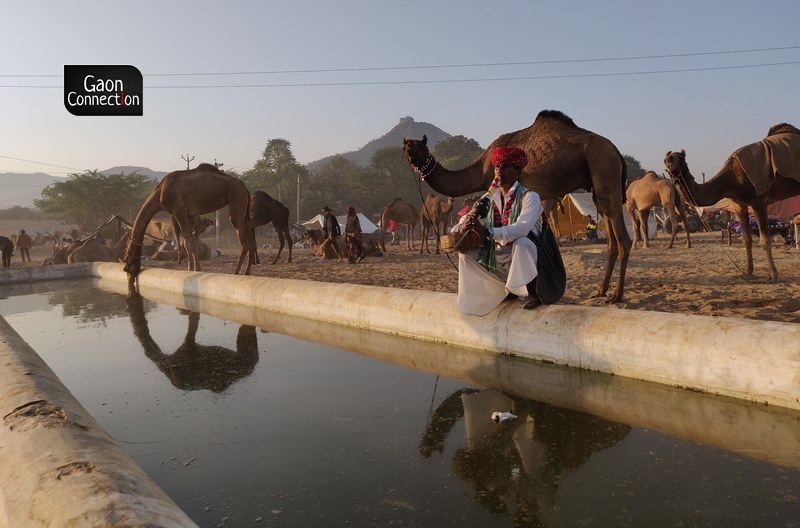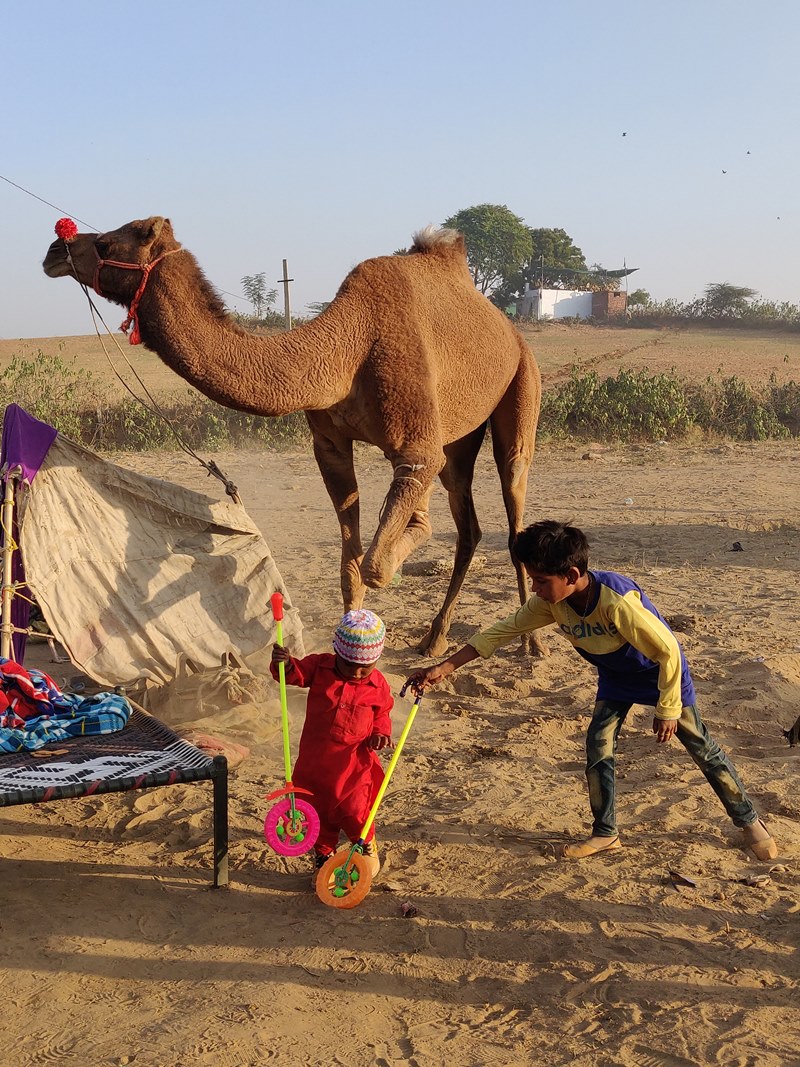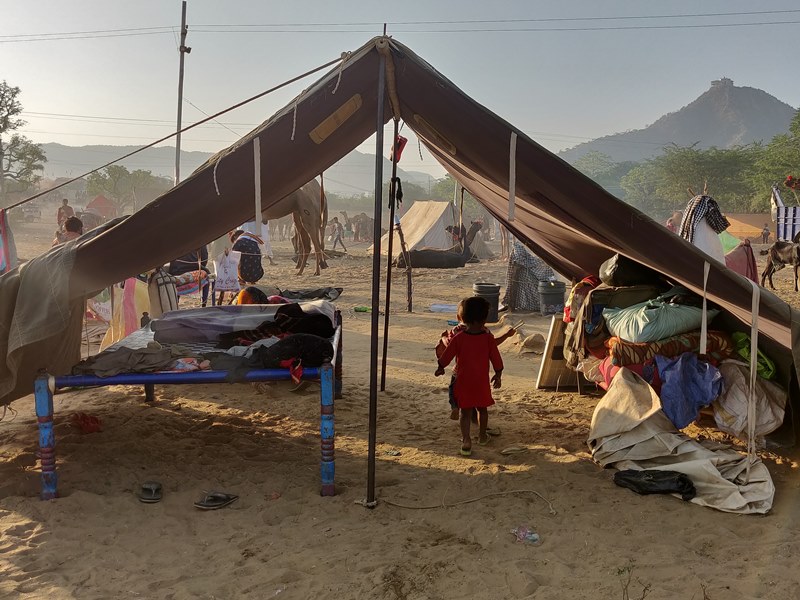Pushkar’s camel fair is back after a two-year hiatus, but the response to it is lacklustre
Their animals are no longer drawing in the crowds, say camel herders. Shrinking number of camels, mechanisation and a stringent law that prevents them from selling the animals outside the state is taking a toll on their only source of income, they say.


The COVID19 pandemic has caused the camel herders considerable distress. All photos: Tabeenah Anjum
It took five days for Hari Ram Raika, his family and his seven camels to walk 183 kilometres from Jodhawar Ki Dhani in Pali district to Pushkar in Ajmer district, Rajasthan for the renowned camel fair. Hari Ram is not alone as several camel herders from the Raika and Rabari community from his village are camping in the mela ground of Pushkar, for the camel fair that is back after two years.
But there is a sense of let down, said Hari Ram. “I have been coming to Pushkar for decades. First as a child accompanying my father, and now with my children and wife,” he told Gaon Connection. “We were so excited to return, but it’s very sad here,” he said in a disappointed tone.
Also Read: Indefinite postponement of animal fairs in Rajasthan due to COVID-19 hits livestock rearers
“The fair was already on a decline with the number of camels decreasing every year. But this year there is hardly any action. There are no buyers, no tourists, but only a few villagers who are not interested in buying camels,” Hari Ram shrugged.
Ram was hoping to sell his camels, but said he had only managed to sell one. “ I could sell it for only fifteen thousand rupees, whereas three years ago I would have got at least forty thousand rupees for it,” the camel herder complained. He added that sometimes they could get up to Rs 90,000 a camel. Hari Ram is not looking forward to the return trip to his village with most of his camels unsold.
“I have been here almost a week. My family is here and we have all given up our daily wage work to be here. But not a single camel has been bought from us,” Shanta Bhalu Raika, another camel rearer from Nagaur that lies about 130 kilometres from Pushkar, told Gaon Connection. He lamented that even the money they might have made from tourists wanting a camel ride is not there this time as there are hardly any tourists at the mela this time.

Covid adds to the woes
The COVID19 pandemic has caused the camel herders considerable distress. “Survival has been difficult these past eighteen months. We would eke out a living by lending our camels for ploughing land, etc., but even that has eluded us during the lockdowns,” Bhalu said. “Our miseries have doubled in the last two years,” he said.
Where once the Pushkar mela was throbbing with colour, sounds of music, haggling voices and the grunts of animals, this time, there are just some straggling camels here and there and barely any people in the vast Pushkar desert. Camel carts stand around forlornly while the Rawanhatta (an ancient string instrument) player has no audience to hear his music.
Also Read: Lockdown woes: Many camels in Rajasthan are succumbing to a contagious skin disease
The Pushkar Camel Fair or Pushkar Mela is an annual livestock fair that starts with the Hindu calendar month of Kartik and ends on the Kartik Purnima. It is one of India’s largest camel, horse and cattle fair. Apart from trading livestock, it is also an important pilgrimage for Hindus who throng the Pushkar Lake, and a popular destination for domestic and international travellers.
In times before COVID19, there were dance and music events, sporting events, competitions and camel races the sounds of which would resound across the desert. But there is nothing this year except the vast emptiness of the arena.
As per the data from the state’s Animal Husbandry department around 2,400 camels were brought to the Pushkar cattle fair this year, which is less than the 3,300 camels that came here in 2019. In 2001, 15,460 camels were bought and sold at the fair while in 2011, the number had come down to only 8,200 camels.
“So far only about twenty per cent of the camels have been sold. The prices range between fifteen to forty five thousand rupees,” an official working with the Animal Husbandry department told Gaon Connection.
Also Read: Villages in Jaisalmer stare at drought but Banjaron Ki Dhani has clean and safe drinking water

Dwindling numbers
The pandemic has added another layer of woes to the Raika and Rabari communities in Rajasthan who have traded in camels for centuries. Their livelihoods suffered when the Rajasthan Camel (Prohibition of Slaughter and Regulation of Temporary Migration or Export) Act, 2015 came into being. The Act stopped the export of camels outside the state territory for slaughter. However, activists working for the welfare of the camels and their breeders believe that far from increasing the camel population has only hindered their sale. The activists are demanding the amendment to the 2015 Act.
“The sale of camels outside the state and its use as transportation should be allowed. The ban has affected the sale and impacted the lives of herders, “Hanwant Singh Rathore, director, Lokhit Pashu Palak Sansthan, a body working for the rights of camel breeders in Rajasthan, explained to Gaon Connection.

On September 2, 2021, the Rajasthan high court also took suo moto cognizance of the sharp decline in the camel population in the state. Two months later, advocate Prateek Kasliwal who has been appointed as amicus curiae (friend of the court) to suggest changes in the law enacted in 2015. Kasliwal submitted a report to the Rajasthan High Court which said camels continue to be “slaughtered illegally” even as camel herders continue to suffer “colossal monetary loss”.
According to the report, when the camel was declared a state animal and the Act came into effect, the camel herders expected that their camels would be saved. Instead, the Act of 2015 did not in any way help in preserving the camel population. In fact, it caused the camel population to decline even further to what it had been before the Act came into effect.
The report pointed out that the ban on slaughtering and export of camels have rendered the camels worthless to the herders who are now getting rid of them illegally to slaughterhouses as they neither have the means to feed or take care of the animals. And the blanket ban on transportation of both male and female camels has led to a colossal monetary loss for herders.
The report points out that despite section 3 of the 2015 Act prohibiting the slaughter of camels, they continue to be slaughtered.
On September 17, 2021, Lal Chand Kataria, minister, agriculture, animal husbandry & and fisheries department, government of rajasthan, had said, in parliament, that the main reason for the decline in the number of camels is the continuous development of mechanical resources and transport facilities even in the villages.
According to the 20th Livestock Census in 2019, the number of camels in the state in in 2012 was 325,000. But, by 2019, the numbers had dipped to 213,000, a dip of almost 35 per cent in just seven years.
However, the local camel breeders and the non profits working in the field claim that the actual numbers are even lower and hover around 150,000.

